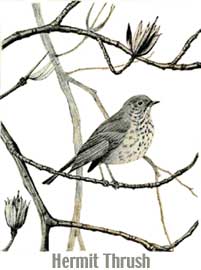Earth Journal
In Season ~ Hermit Thrush (and lots more)
story and illustration by Gary Pendleton
 I needed to get some exercise and give my eyes a break while I was at it. So on a day when the temperature dropped deep into the 20s, I went to the woods, where it was quiet and cold but not windy. I would walk and look for birds to get my mind off business and the mysterious cracks that have been appearing in my plaster walls.
I needed to get some exercise and give my eyes a break while I was at it. So on a day when the temperature dropped deep into the 20s, I went to the woods, where it was quiet and cold but not windy. I would walk and look for birds to get my mind off business and the mysterious cracks that have been appearing in my plaster walls.
Usually it is quiet and empty in the woods in winter. You can go for long stretches and see nothing but the dormant trees with their small, tight buds, and the roots of wildflowers just a few inches below the leaf litter.
A deer broke apart the silent stillness. First came a sudden and harsh rustling of many leaves and twigs breaking. Then a tawny-brown ripple blurred the tawny-brown background of leaves covering the ground below the bluff. The blur coalesced into a form with legs and a head as tall as mine. It came close enough for me to feel vibrations coming up from the ground through my shorter, weaker, heavier legs. It changed direction and flashed the white flag that is its tail. Then it bounded out of sight, and all was quiet again.
A little way down the trail, I heard a thin lisping sound that betrayed the presence of a brown creeper, an odd little brown bird that crawls up the trunks of trees, probing with its thin bill underneath the bark for whatever it can find of substance. The creeper moves straight up the trunk, never down or sideways. It goes up and up until — suddenly — it flies a looping reverse course to the base of any close-by tree, where it begins again.
Our winter woods are occupied by a particular combination of birds. Some can be found year-round in a variety of habitats; others, such as the creeper, have migrated from the north. Like juncos, they are snowbirds of a woodland sort that rarely venture out to the suburbs. They form mixed flocks that course through the woods in a loose aggregate of species. It’s odd that chickadees and titmice (species that scientists consider closely related) would consort with woodpeckers, nuthatches, kinglets and creepers, but that seems to be the case.
Suddenly birds were present all around me. The sum total of their vocalizations amounted to less than one footfall of the noisy deer and their total weight less than a pound, I’d guess.
I later came across another winter visitor, the honorable state bird of New Hampshire, plucking red berries from a holly tree. The brown- and rust-colored hermit thrush is shaped like its larger cousin the robin. It is more solitary than some others that over-winter here; it does not associate with the mixed flocks.
One might wonder why those 1930s’ school children from the Granite State chose a state bird not hardy enough to endure the year-round climate of New England. But one might also ask why the oriole is in Costa Rica right now. It could be the oriole is one smart bird, but a better answer would be that both species migrate in search of suitable food and shelter.